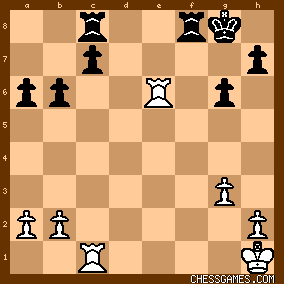g15713: E. 1.0
Black to move at 28

click for larger viewDouble rook ending quickly becomes a single rook ending Game continued:
28...Rf2 29. Rxb6 cxb6 30. Rxc8+ Kg7 31. Rc7+ Kh6 E. 1.1
White to move at 32
White is going to lose a pawn the question is how should one proceed? 
click for larger viewStockfish gives the following analysis after 60-minute evaluation
It appears the following positions are drawish.
1) -1.29 (55 ply) 32.Rb7 Rxb2 33.a4 a5 34.Kg1 Rb4 35.h4 Rxa4 36.Rxb6 Ra2 37.Rb7 g5 38.hxg5+ Kg6 39.Rb5 a4 40.Rd5 Ra1+ 41.Kh2 a3 42.Ra5 a2 43.Kg2 Kf7 44.Ra7+ Ke6 45.Ra5 Kd6 46.Ra3 Kc5 47.Ra7 Kb5 48.Kh2 Kc4 49.Rc7+ Kb4 50.Rb7+ Kc5 51.Ra7 Kb6 52.Ra3 Kc7 53.Ra6 Kb7 54.Ra3 Kb6 55.Ra4 Kc6 56.Ra7 Kb5 57.Ra3 Kb4 58.Ra7 Kb3 59.Rb7+ Kc3 60.Rc7+ Kb2 61.Rb7+ Kc2 62.Rc7+ Kd3 63.Ra7 Ke4 64.Ra4+ Ke3 65.Ra5 Kd4 66.Ra7 2) -1.29 (54 ply) 32.a4 Rxb2 33.Rb7 a5 34.Kg1 Rb4 35.h4 Rxa4 36.Rxb6 Ra2 37.Rb7 g5 38.hxg5+ Kg6 39.Rb5 a4 40.Rd5 Ra1+ 41.Kh2 a3 42.Ra5 a2 43.Kg2 Kf7 44.Ra7+ Ke6 45.Ra5 Kd6 46.Ra3 Kc5 47.Ra7 Kb5 48.Kh2 Kc4 49.Rc7+ Kb4 50.Rb7+ Kc5 51.Ra7 Kb6 52.Ra3 Kb7 53.Kg2 Kc6 54.Ra7 Kb6 55.Ra4 Kb5 56.Ra7 Kc4 57.Kh2 Kd5 58.Kg2 Kd4 59.Ra6 Kc3 60.Ra7 Kb3 61.Rb7+ Kc4 62.Ra7 Kd5 63.Kh2 Kd6 64.Ra5 Kc6 65.Ra7 3) -1.29 (54 ply) 32.Kg1 Rxb2 33.a4 Rb4 34.Rb7 a5 35.h4 Rxa4 36.Rxb6 Ra2 37.Rb7 g5 38.hxg5+ Kg6 39.Rb5 a4 40.Rd5 Ra1+ 41.Kh2 a3 42.Ra5 a2 43.Kg2 Kf7 44.Ra7+ Ke6 45.Ra5 Kd6 46.Ra3 Kc5 47.Ra7 Kb5 48.Kh2 Kc4 49.Rc7+ Kb4 50.Rb7+ Kc5 51.Ra7 Kb6 52.Ra3 Kb7 53.Kg2 Kb8 54.Ra6 Kc7 55.Kh2 Kb7 56.Ra3 Kb6 57.Ra4 Kc6 58.Ra7 Kb5 59.Kg2 Kb4 60.Rb7+ Ka4 61.Ra7+ Kb3 62.Rb7+ Kc2 63.Rc7+ Kd3 64.Ra7 Kc4 Game continued with:
32. Ra7 a5 33. b4?!
(I consider this a questionable move, why allow Black to capture the a-pawn on the second rank. Instead White should play
33. a4 Rxb2 34. Rb7 Rb4 35. Kg2)
33...Rxa2 34. bxa5 bxa5 35. Kg1 a4
E. 1.2
White to move at 36

click for larger viewThe defending rook is behind the passed pawn, keeping an eye on both a-pawn and the kingside pawns; typically a drawn position.
<Fly in the ointment> is that defender's king is cutoff on the first rank.
Black's plan of course is to push the a- pawn to a3 and bring his king to the aid of his passed pawn. If 36. h4 then Kh5 37. Rxh7+ Kg4 38. Rg7 Kh3 or a3 Black wins Instead after 36. g4! (threatens h4) Kg5 37. Rxh7 Kxg4 (a3 is met by Rh3)
Syzygy says White can draw with 38. Rc7!
'https://syzygy-tables.info/?fen=8/7... Look at a similar end game 'Bologan vs Dreev, 2006
Chess 'User: Peligroso Patzer
<"Although not a pure example, White's defense here is based on the Vancura study (1924). See:
'https://www.angelfire.com/games4/li..."> Game continued:
FinalGen says White is lost after 36. h3 a3
36. h3? a3 37. h4 g5? (37...Kh5! followed by h6 and g5 wins) 38. hxg5+ Kxg5 39. Ra4 Kf5 40. Rf4+ Ke5 41. Rf3 Ke4 42. Rb3 Kf5 43. Rc3 Kg4 44. Rb3 Kh3 45. g4+ Kxg4 46. Kh1 Kf4 47. Kg1 Ke4 48. Kh1 Kd4 49. Rf3 h5 50. Rb3 Kc4 51. Rf3 Kb4 52. Rf4+ Kc3 53. Rf3+ Kc4 54. Rf4+ Kd3 55. Rf3+ Ke2 56. Rg3 Ra1+ 57. Kg2 h4 58. Rb3 Ra2 59. Kh1 Kd1 60. Rf3 Ke1 61. Rd3 Ra1 62. Kg2 Ke2 63. Rb3 Kd2 64. Rf3 h3+ 65. Kh2 Ke2 66. Rb3 Ra2 67. Kh1 Ke1 68. Rd3 Ra1 69. Kh2 Ke2 70. Rb3 Kd2 71. Rf3 Kc2 72. Rf2+ Kd3 73. Rf3+ Kc4 74. Rf4+ Kc5 75. Rf5+ Kd4 76. Rf3 Ra2+ 77. Kh1 1/2-1/2 | 




































